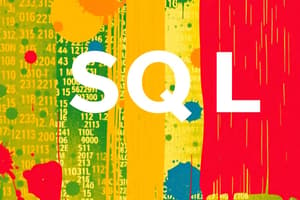Podcast
Questions and Answers
When is a DBMS not necessary?
When is a DBMS not necessary?
- When there are stringent real-time requirements.
- When the database and applications are simple and well defined. (correct)
- When access to data by multiple users is required.
- When the database users need special operations not supported by the DBMS.
What is one of the limitations of DBMS?
What is one of the limitations of DBMS?
- Storage space in embedded systems.
- Support for location-based services.
- Modeling limitations in complex genome and protein databases. (correct)
- Real-time requirements in telephone switching systems.
What is one of the main characteristics of the database approach?
What is one of the main characteristics of the database approach?
- High storage requirements.
- High complexity modeling.
- Support for real-time requirements.
- Support for multiple users. (correct)
What is an example of a database application?
What is an example of a database application?
When is a DBMS infeasible?
When is a DBMS infeasible?
What is one of the advantages of using the database approach?
What is one of the advantages of using the database approach?
What is one of the types of database users?
What is one of the types of database users?
What is one of the functionalities of a DBMS?
What is one of the functionalities of a DBMS?
What is one of the historical developments of database technology?
What is one of the historical developments of database technology?
When is a DBMS not sufficient?
When is a DBMS not sufficient?
What is one of the disadvantages of using a DBMS?
What is one of the disadvantages of using a DBMS?
Flashcards are hidden until you start studying
Study Notes
Types of Databases and Applications
- Traditional applications include numeric and textual databases
- More recent applications include multimedia databases, geographic information systems (GIS), biological and genome databases, data warehouses, mobile databases, and real-time and active databases
Recent Developments
- Social networks capture a lot of information about people and communications among people
- Search engines like Google, Bing, and Yahoo collect their own repository of web pages for searching purposes
- New technologies are emerging from non-database software vendors to manage vast amounts of data generated on the web
- NOSQL (Not Only SQL) systems and Big Data storage systems involving large clusters of distributed computers are emerging
- A large amount of data resides on the “cloud” in huge data centers using thousands of machines
Main Characteristics of the Database Approach
- Sharing of data and multi-user transaction processing
- Allowing a set of concurrent users to retrieve from and update the database
- Concurrency control within the DBMS guarantees that each transaction is correctly executed or aborted
- Recovery subsystem ensures each completed transaction has its effect permanently recorded in the database
- OLTP (Online Transaction Processing) is a major part of database applications, allowing hundreds of concurrent transactions to execute per second
Database Users
- Database administrators are responsible for authorizing access to the database, coordinating and monitoring its use, acquiring software and hardware resources, controlling its use, and monitoring efficiency of operations
- Database designers define the content, structure, constraints, and functions or transactions against the database
- End-users use the data for queries, reports, and some of them update the database content
Historical Development of Database Technology
- Early database applications used hierarchical and network models, which still dominate the market
- Relational model was introduced in 1970 and relational DBMS products emerged in the early 1980s
- Object-oriented and emerging applications include object-oriented database management systems (OODBMSs) and object-relational DBMSs (ORDBMSs)
- Data on the web and e-commerce applications use XML, HTML, and script programming languages like PHP and JavaScript
Extending Database Capabilities
- DBMSs are adding new functionality in areas like scientific applications, earth and atmospheric sciences, astronomy, XML, image storage and management, audio and video data management, data warehousing and data mining, spatial data management, and time series and historical data management
When Not to Use a DBMS
- If the database and applications are simple, well-defined, and not expected to change
- If access to data by multiple users is not required
- If the database system is not able to handle the complexity of data because of modeling limitations
- If the database users need special operations not supported by the DBMS
Studying That Suits You
Use AI to generate personalized quizzes and flashcards to suit your learning preferences.




